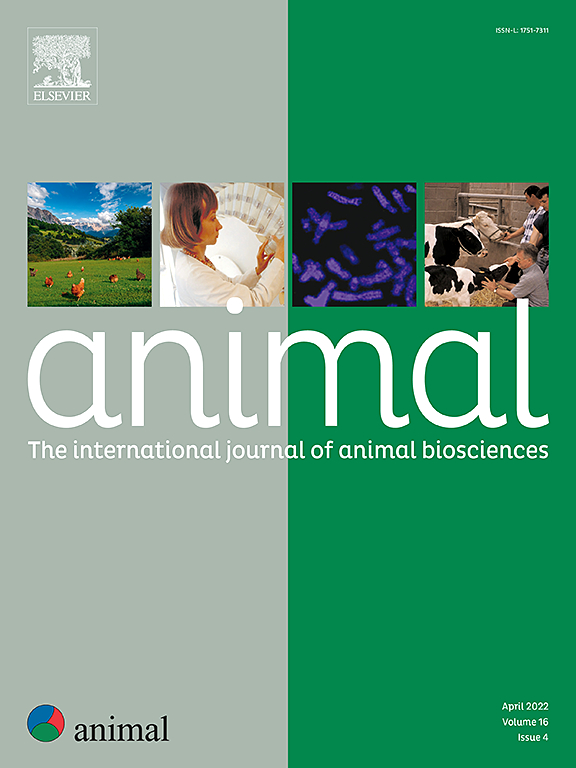Genome-wide association study implicates possible causal genes for growth, fatness, and reproductive traits in pig
IF 4.2
2区 农林科学
Q1 AGRICULTURE, DAIRY & ANIMAL SCIENCE
引用次数: 0
Abstract
Growth, fatness, and reproductive traits are key economic traits that significantly influence the efficiency and long-term sustainability of commercial pig production. While genome-wide association study (GWAS) has proven to be an effective approach for identifying genetic variants associated with key traits, the significant loci identified by GWAS do not necessarily correspond to the true causal genes. To address this, we performed GWAS on 4 560 pigs from three populations to investigate six traits: right teat number (RTN), left teat number (LTN), body length (BL), body height (BH), BW and backfat thickness (BFT). We incorporated three post-GWAS analyses: expression quantitative trait loci mapping, Bayesian colocalisation analysis, and Mendelian randomisation to prioritise candidate causal genes. Genes supported by at least two independent lines of evidence were prioritised as high-confidence causal candidates. GWAS identified one novel lead single nucleotide polymorphism (SNP) on Sus scrofa chromosome 7 (SSC7) for teat number and two new lead SNPs for BFT on SSC1 and SSC18. A total of 16 and 23 potential causal genes were identified for LTN and RTN, respectively. Among these, four genes (ABCD4, ALDH6A1, ENTPD5, and ISCA2) were supported by all four lines of evidence for both traits. For BL, four out of ten candidate genes (ABCD4, PTGR2, ENTPD5 and FAM161B) received full support. For BFT, two of 23 genes (EXOSC2 and USP20) were fully supported. Regarding BW, among six genes, ASS1 ranked the highest and was supported by three lines of evidence. For BH, 12 genes, including PTK6 and STMN3, were supported by two lines of evidence. In summary, the integration of GWAS with multiple post-GWAS analyses provides a powerful and systematic strategy to refine association signals and prioritise putative causal genes. The novel loci and candidate genes identified expand genetic resources for marker-assisted selection and provide insights into the genetic basis of growth performance and reproductive traits in the pig industry.
全基因组关联研究暗示了猪生长、肥胖和繁殖性状可能的因果基因
生长、肥壮和繁殖性状是影响商品生猪生产效率和长期可持续性的关键经济性状。虽然全基因组关联研究(GWAS)已被证明是鉴定与关键性状相关的遗传变异的有效方法,但GWAS鉴定的重要位点并不一定与真正的致病基因相对应。为了解决这个问题,我们对来自3个群体的4 560头猪进行了GWAS,研究了6个性状:右乳头数(RTN)、左乳头数(LTN)、体长(BL)、体高(BH)、体重和背膘厚度(BFT)。我们结合了三种gwas后分析:表达数量性状位点定位、贝叶斯共定位分析和孟德尔随机化,以确定候选因果基因的优先级。至少有两条独立证据支持的基因被优先考虑为高可信度的因果候选。GWAS鉴定出一个新的单核苷酸多态性(lead single nucleotide polymorphism, SNP)在苏氏丝瓜7号染色体(SSC7)上,以及两个新的单核苷酸多态性(lead single nucleotide polymorphism, SNP)在SSC1和SSC18上。共鉴定出LTN和RTN的16个和23个潜在致病基因。其中,四个基因(ABCD4、ALDH6A1、ENTPD5和ISCA2)在这两个性状中都得到了所有四条证据的支持。对于BL, 10个候选基因中有4个(ABCD4、PTGR2、ENTPD5和FAM161B)得到了完全支持。对于BFT, 23个基因中的2个(EXOSC2和USP20)被完全支持。关于体重,在6个基因中,ASS1排名最高,有3条证据支持。对于BH,包括PTK6和STMN3在内的12个基因得到了两种证据的支持。总之,GWAS与多种GWAS后分析的整合提供了一种强大而系统的策略来细化关联信号并优先考虑假定的因果基因。新发现的基因座和候选基因为标记辅助选择扩大了遗传资源,并为养猪业的生长性能和繁殖性状的遗传基础提供了见解。
本文章由计算机程序翻译,如有差异,请以英文原文为准。
求助全文
约1分钟内获得全文
求助全文
来源期刊

Animal
农林科学-奶制品与动物科学
CiteScore
7.50
自引率
2.80%
发文量
246
审稿时长
3 months
期刊介绍:
Editorial board
animal attracts the best research in animal biology and animal systems from across the spectrum of the agricultural, biomedical, and environmental sciences. It is the central element in an exciting collaboration between the British Society of Animal Science (BSAS), Institut National de la Recherche Agronomique (INRA) and the European Federation of Animal Science (EAAP) and represents a merging of three scientific journals: Animal Science; Animal Research; Reproduction, Nutrition, Development. animal publishes original cutting-edge research, ''hot'' topics and horizon-scanning reviews on animal-related aspects of the life sciences at the molecular, cellular, organ, whole animal and production system levels. The main subject areas include: breeding and genetics; nutrition; physiology and functional biology of systems; behaviour, health and welfare; farming systems, environmental impact and climate change; product quality, human health and well-being. Animal models and papers dealing with the integration of research between these topics and their impact on the environment and people are particularly welcome.
 求助内容:
求助内容: 应助结果提醒方式:
应助结果提醒方式:


